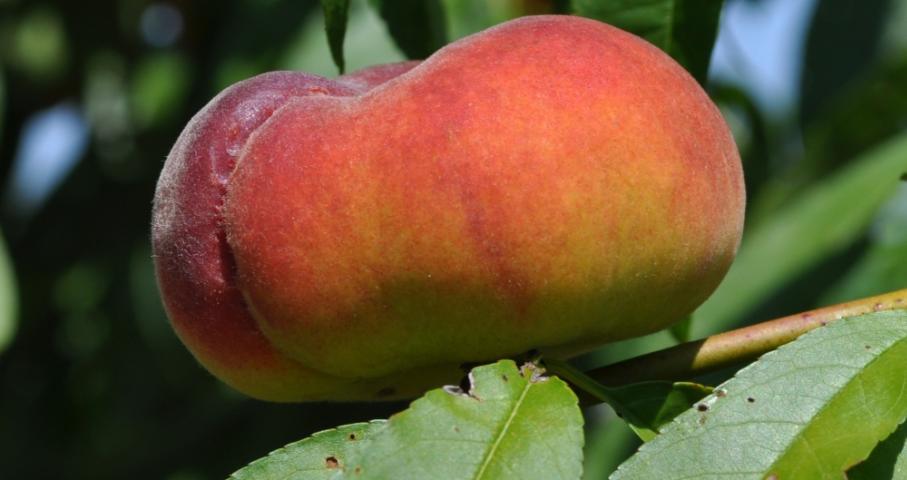
by Ray Bodrey | Mar 6, 2019
I’m a native of Georgia, growing up just south of the region known as “peach country”. To me, there’s nothing better than a ripe, juicy peach on a summer day. I thought I had seen it at all when it came to peaches. That changed on a trip to the southwest U.S.
A few years ago, I was fortunate to make the voyage to Utah for the National Association of County Agricultural Agents annual meeting. A small group of county agents also participated in a pre-tour of the southwest region of Utah. This is where I found a treasure in the desert, as a host extension agent shared some of his oddly shaped, Saturn peaches from a nearby orchard.
The Saturn peach is a favorite in Utah and a favorite for hundreds of years in Asia. This is an asymmetrically shaped peach, with white, firm flesh. Some refer to this as a “donut peach”. It is an interesting fruit, that I must admit was one of the most delicious peaches that I’ve ever eaten.
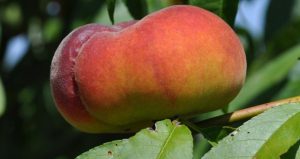
Figure 1. “UFO” Peach.
Credit: Ali Sarkhosh, Mercy Olmstead, Jose Chaparro, Pete Andersen and Jeff Williamson. UF/IFAS Extension
I began to ponder why this peach variety was one that I had never encountered? After consulting with extension agents in neighboring southeastern states, I found that many universities had experimented with the variety. However, pitfalls in climate acclimation, mechanical harvesting (because the fruit is not round, harvesting equipment can damage) and marketing were discouraging. From a large commercial production interest, even if a viable yield could be grown in the region and custom designed harvesters were feasible, hurdles would still remain regarding the difficulty of marketing an introduced variety that has an unfamiliar and imperfect shape, versus well established varieties that can be graded as select. However, a healthy market may exist for small farms as novelty crop.
Furthermore, in 2002 UF/IFAS researchers breed and patented a similar variety of the Saturn peach that thrives anywhere in Florida. The Australia saucer peach was used to breed this new variety, known as the flying saucer or “UFO”. This peach has non-melting flesh with that unique donut shape, not unlike the Saturn. These trees are large and vigorous growing, with a semi-upright growth habit. The UFO produces moderately heavy crop loads of large, firm fruit with yellow flesh and semi-freestone pits that has a fruit development period of 95 days. As seen in figure 1, the skin develops 50–70% blush. This cultivar is particularly susceptible to ethylene that is released during dormant pruning, which can result in significant flower bud abortion. Thus, pruning is only recommended during the summer period.
Where do I find such a tree? Growers can purchase from nurseries who are licensed by the University to grow patented varieties. What about homeowners? Check your local garden centers. Now is great time to plant.
For more information please contact your local extension office.
Supporting information for this article obtained through past interviews of Dr. Wayne Sherman, Professor Emeritus, Department of Horticultural Sciences, UF/IFAS as well as from the following the UF/IFAS EDIS publication: “Florida Peach and Nectarine Varieties” by Ali Sarkhosh, Mercy Olmstead, Jose Chaparro, Pete Andersen and Jeff Williamson: https://edis.ifas.ufl.edu/pdffiles/MG/MG37400.pdf
UF/IFAS Extension is an Equal Opportunity Institution.

by Beth Bolles | Feb 14, 2017
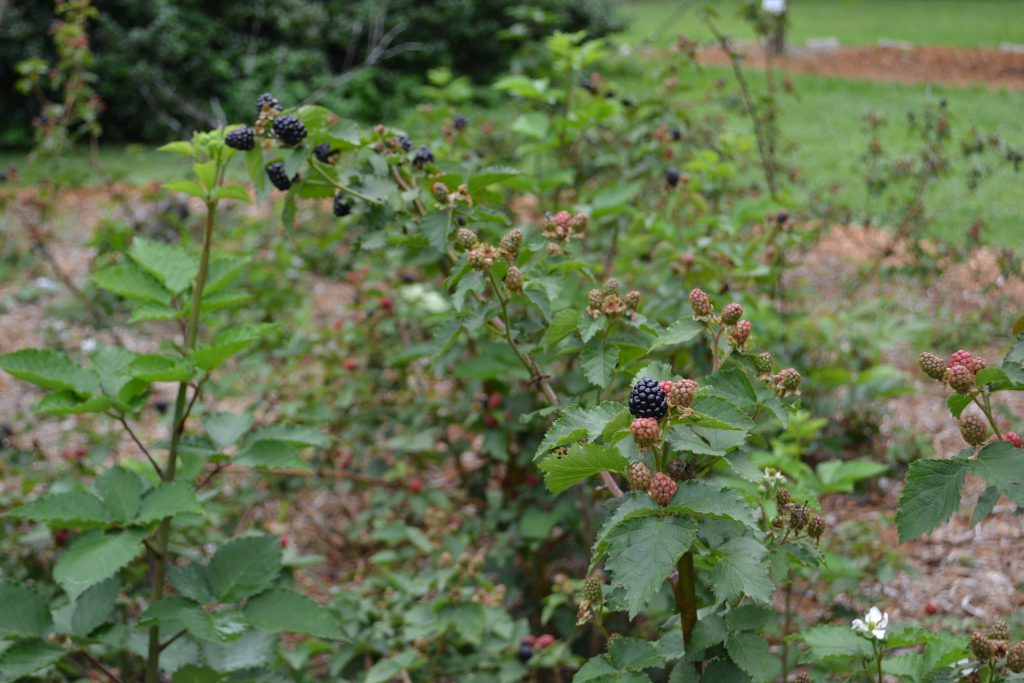
Arapaho blackberry has chill requirements that match those received in our area. Photo by Beth Bolles, UF IFAS Extension
Many of us are enjoying warmer temperatures this winter, but many deciduous fruit crops really need cold temperatures in order to break dormancy for the year. In areas that experience cold temperatures, plants have evolved the ability to survive by slowing growth and protecting sensitive tissues by going dormant. In order to break out of dormancy and begin growth again, plants experience an amount of chill hours (temps between 32 and 45 degrees F) that is suitable for specific areas. In our area, we normally range between 400 and 600 chills hours.
If we choose a fruit plant whose chill requirements match the amount of chill in our area, the plant will generally resume growth when it is safe for buds and tender tissues to develop. If we choose a plant with chill requirements higher than the amount our area receives, then the plant is not signaled to break dormancy and we end up with very sparse growth and no fruit.
So far in the winter of 2016-17, some areas have not received ‘normal’ amounts of chilling temperatures. Common fruit like apple, peach, some blueberries, and certain selections of blackberries may be affected by this by not breaking out of dormancy. This can impact your flower and fruit formation. For commercial growers, it can impact the amount of fruit available and even fruit prices at markets.
Since fruit trees are an investment of time and money, these are not plants that can be easily replanted to match chill hours with changing weather patterns. Perhaps planting fruit crops with a range of chill hours required might be beneficial Your future decisions to grow fruit trees may include crops that don’t rely as much on chill hours to be successful. For more information, please consult the Dooryard Fruit Varieties guide from UF / IFAS Extension.
by Larry Williams | Feb 11, 2014
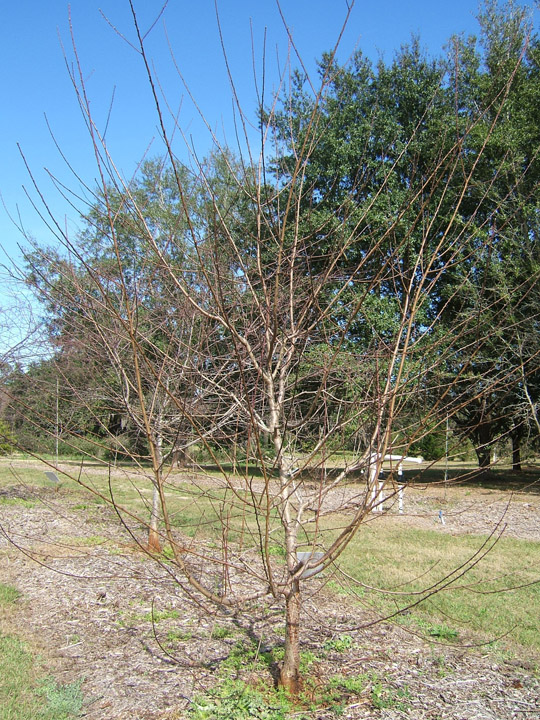
Dormant Peach Tree. Image Credit UF IFAS Environmental Horticulture Department
It is hard to believe with all of this recent cold weather, but now is the time to plant fruit trees in the Florida Panhandle. When planning what type of fruit tree to plant, correct cultivar selection should be the top priority.
The dooryard fruit producer oftentimes finds it difficult to choose the correct fruit cultivar for this area. An inappropriate choice results in disappointment when home gardeners find that they have paid for, planted and cared for fruit trees that are not adapted to the Northwest Florida climate.
Weather is probably the most important factor determining where certain fruits can and cannot be grown.
Most fruits which grow in the northern part of Florida are deciduous, which means that during the winter the trees lose their leaves and go into a period of dormancy, or rest.
During this rest period, the tree must be exposed to chilling temperatures. This exposure to the cold prepares the plant to resume active growth in spring. Temperatures below 45°F accumulated throughout winter determines the total hours of chilling. Species differ in the amount of chilling they need. This is known as a plant’s chilling requirement. Lack of enough chill hours result in sparse foliage and little to no flower production. And if there are no flowers, there will be no fruit.
North Florida receives between 400 to 650 hours below 45°F during the average winter. This provides enough chill hours for a few apple cultivars such as Anna, Ein Shemer, Dorsett Golden, TropicSweet and Shell. However, it does not provide the chill hours required for many of the more common varieties such as Red Delicious and Golden Delicious.
This same environmental factor holds true for most deciduous fruit trees. For example, some of the better known peach cultivars, such as Elberta and Bell of Georgia, perform poorly here following most winters. Both require roughly twice as many chill hours as the Panhandle receives during most winters. There are a few peach cultivars that perform OK in our area.
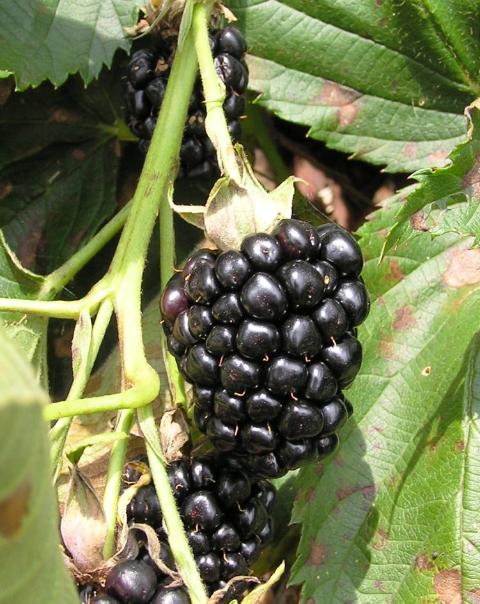
Blackberry Fruit. Photo Credit: Theresa Friday, Santa Rosa County, UF IFAS Extension
The results of selecting the wrong cultivar is only one of the disappointments experienced by those wishing to grow fruits in North Florida. Even when the correct cultivar is selected, many fruit enthusiasts (people who have dreams of homemade peach cobbler, apple pies, plum jelly, etc.) are disappointed to see insects eating their fruit, diseases causing their fruit to rot or possibly all their fruit falling to the ground before it is ready to be eaten.
In order to be successful with fruit production in North Florida, a person needs to ask a lot of questions before planting the first plant.
- Which cultivars grow well here?
- How much care is needed to grow this type of fruit?
- Do I have the time to devote to pruning, spraying, fertilizing and watering?
If you don’t know the answers to these questions, talk to a knowledgeable employee at a local, reputable nursery, consult the Dooryard Fruit Selection publication, or call your UF IFAS Extension Office before choosing to plant fruit trees this winter.
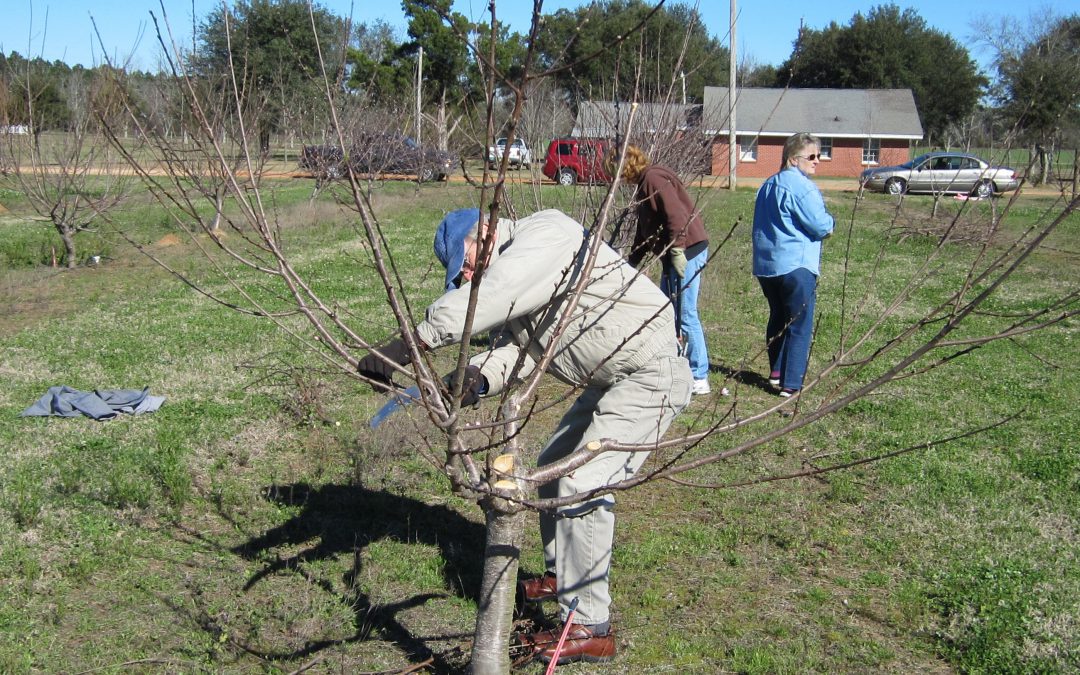
by Blake Thaxton | Feb 4, 2014
February is not a month many think of as a big gardening month, although the preparation and maintenance practices performed in February can be critical to the success of an orchard for the rest of the year. Stone Fruit (Peaches, Nectarines) in particular need special care in the dormant season. During the dormant season pruning must be done to develop the best shape for the stone fruit species to bear fruit. Also, because of the disease pressures associated with stone fruit in Northwest Florida, some chemical sprays need to be added to the agenda in order to control disease and insect pests.
Pruning
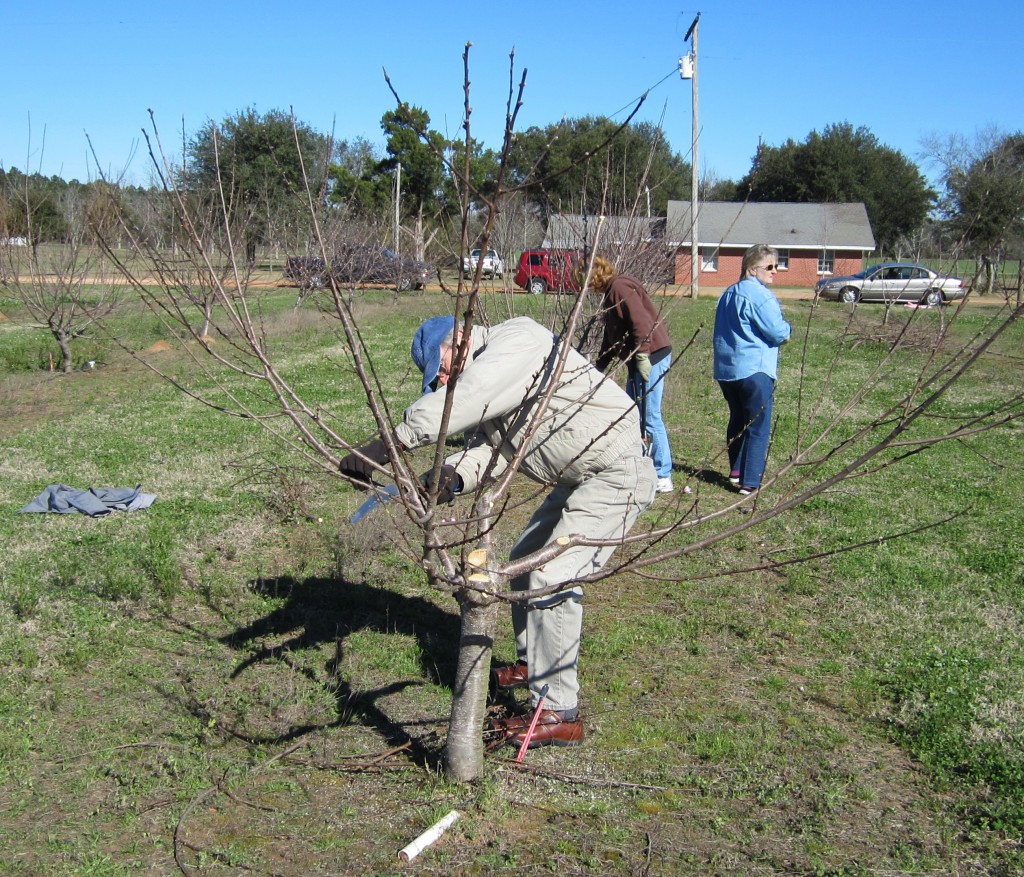
Santa Rosa County Master Gardener Pruning a Stone Fruit tree at the WFREC
Peaches and Nectarines should be pruned to an open center or vase shape. This will allow a well distributed fruit set to develop and will keep the crop load at a controlled amount that can produce quality fruit. During the first year of dormancy a main scaffold (3 or 4) should be chosen to form the open vase shape structure that is desired. The desired scaffolds should be 6 inches apart vertically and sit at a 45° angle from the trunk of the tree. At the second year of dormant pruning, two to three secondary branches should be selected off of each scaffold branch. Remove all of the other secondaries off of the scaffolds and prune back the selected secondaries to 20-36 inches. The following video by the North Carolina Extension Service will give a good idea how Peaches and Plums need to be pruned.
For more information on pruning: Training and Pruning Florida Peaches, Nectarines, and Plums
Dormant Spray
This time of year trees are dormant, so action is critical to stay ahead of disease and insect pests. Peaches and Nectarines need to be sprayed with several products in order to help guard against Scale insects and Mites, Bacterial Spot, and Leaf Curl. Dormant or horticultural oils need to be applied twice 10-14 days apart for Scale and Mites. Oil efficacy is determined by coverage, as the material suffocates pests. Oil sprays need to be performed when temperatures are between 40º and 85º F. Do not apply oil after bud break. A copper based fungicide labeled for stone fruit can be sprayed at this time of year for Bacterial Spot and a sulfur based product or Chlorothalonil need to be sprayed for leaf curl control. Do not apply copper products after blooms or leaves appear. Always follow the label when spraying products on fruit trees!
For more information on Peaches and Nectarines visit UF/IFAS Electronic Data Information Source.








